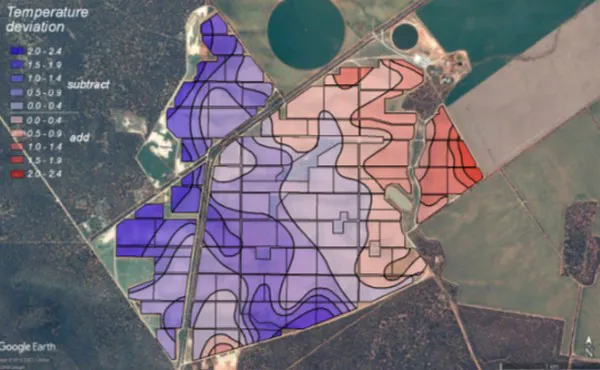The economic costs of frost to agriculture and horticulture can be significant. As winter and early spring frost in Australia and New Zealand is almost exclusively ‘radiative’ in nature, it forms predictable patterns as a function of surrounding topography and land use.
Climate Consulting provide expert analysis of temperature inversions, katabatic drift and near-surface frost profiling. Their site-specific approach allows orchard managers to make informed decisions on the type, extent and precision placement of frost mitigation.
"We provide a ‘service’ to fruit growers. We advise clients of their frost risk, whether frost protection is required, how much is required, how well it will work and where it needs to go to optimise performance," explains Dr Stu Powell from Climate Consulting.
"Deploying a high density of climate equipment across a development enables them to identify the extent of a frost problem. They establish maps of frost risk and frost variability. The maps highlight areas of greatest potential loss and are a powerful tool for quantifying and justifying frost protection,"
The studies can be undertaken any time of the year, no actual frost is needed to work out how one it likely to unfold. During clear settled weather, all of the climate parameters of interested are governed by local terrain, either within the orchard or in the areas closely surrounding. Topography / terrain stays fixed – winter, spring, autumn, so its relatively straight forward to take a sample of data from winter and apply what we find to a period of the year when a crop is vulnerable to frost."
A completed report will detail the frost risk profile (a coloured map of frost risk across the orchard), provide analysis of inversion structure (important if considering wind machines), katabatic wind drift (again critical for accurate placement of wind machines), as well as statistical calculations of frost risk.
 Frost profile across 480 ha property in NWS, Australia.
Frost profile across 480 ha property in NWS, Australia.
While wind machines are highly regarded across the majority of Australia’s agricultural regions, machine spacing, placement and operation are critical to success.
Will frost fans work for us? This is achieved following analysis of inversion strength and consistency. In weaker inversion conditions frost fan spacing is tightened to ensure each machine protects a reduced area. Inversion analysis is coupled with local historic frost data to achieve optimal wind machine density.
How many machines will I need? This is calculated from the frost risk profile map. There is often more than one wind machine configuration option presented at the conclusion of a report. Are wind machines installed where I need them? Katabatic drift speed and direction is recorded by climate towers. This information determines the orientation of a frost fan warming footprint and subsequent precision placement of frost fans.
The density of the climate equipment installation is determined by property size and surrounding terrain. The equipment remains in place for 3 - 6 weeks and in this time sufficient data can usually be collected during clear settled weather. These observations mimic the near-surface environment during spring frost which allows Climate Consulting to define what’s going to work and where protection needs to go.
The cost of this service is reflective of property size and complexity of terrain. The entire investigative process (including analysis and reporting) takes 6 – 12 weeks (determined by property size).
"Climate Consulting has helped hundreds of clients make informed decisions regarding the level, efficacy and optimal placement of frost protection since 2002.
For more information:
Dr Stu Powell
Climate Consulting
Phone: +64 275 927267
[email protected]
www.climateconsulting.co.nz










